Difference Between Conductivity and Molar Conductivity
The key difference between conductivity and molar conductivity is that conductivity is the measure of the ability of an electrolyte to conduct electricity whereas the molar conductivity is the conductivity of an electrolyte measured per unit molar concentration.
Conductivity measures the ability of an electrolyte to conduct electricity through it. In other words, it is a quantitative measure of the conductance of an electrolyte. The ionic species in the electrolyte, i.e., cations and anions, contribute to the conductivity.
CONTENTS
1. Overview and Key Difference
2. What is Conductivity
3. What is Molar Conductivity
4. Side by Side Comparison – Conductivity vs Molar Conductivity in Tabular Form
5. Summary
What is Conductivity?
Conductivity is the measure of an electrolyte’s ability to conduct electricity through it. An electrolyte is a substance that can produce a solution that has the ability to conduct electricity when we dissolve it in a polar solvent such as water. Therefore, the electrolyte should produce ionic species upon dissolving: cations or positive charged ions and anions or negative charged ions.

Figure 1: Conductivity Meter
The SI unit for the measurement of conductivity is S/m (Siemens per meter). Usually, we measure this at 25°C temperature. However, in industries, we use this often as μS/cm, as a traditional unit. We can determine the conductivity of an electrolytic solution by determining the resistance of the solution between two flat electrodes separated by a fixed distance. Here, we should use an alternating current in order to avoid electrolysis. Furthermore, we can measure this resistance using a conductivity meter.
What is Molar Conductivity?
Molar conductivity is the conductivity of an electrolytic solution measured per unit molar concentration of the solution. We can determine this as the conductivity of the electrolytic solution divided by the molar concentration of the electrolyte. Therefore, we can give the molar conductivity in the following equation:
Molar conductivity = k/c
k is the measured conductivity of the electrolytic solution and c is the concentration of the electrolytic solution.
What is the Difference Between Conductivity and Molar Conductivity?
Conductivity is the measure of an electrolyte’s ability to conduct electricity through it while molar conductivity is the conductivity of an electrolytic solution measured per unit molar concentration of the solution. Therefore, this is the key difference between conductivity and molar conductivity. Here, we do not consider the molar concentration of the electrolytic solution when determining the conductivity. However, we should consider the concentration of the electrolytic solution when determining the molar conductivity.
The below illustration shows more details on the difference between conductivity and molar conductivity.

Summary – Conductivity vs Molar Conductivity
Molar conductivity is a derivative of conductivity which includes the molar concentration of the electrolytic solution in which we measure the conductivity. In brief, conductivity is the measure of the ability of an electrolyte to conduct electricity. Molar conductivity, on the other hand, is the conductivity of an electrolyte measured per unit molar concentration. Therefore, this is the key difference between conductivity and molar conductivity.
Reference:
1. “Molar Conductivity.” Wikipedia, Wikimedia Foundation, 7 Nov. 2018, Available here.
Image Courtesy:
1. “Electrical conductivity meter” By Nmnogueira at English Wikipedia (CC BY-SA 2.5) via Commons Wikimedia
ncG1vNJzZmivp6x7pbXFn5yrnZ6YsqOx07CcnqZemLyue8OinZ%2Bdopq7pLGMm5ytr5Wau26vzqebrpuknsOqwNhmmKecXaK8ra3RZpqoppSqsLW11aKrsmc%3D